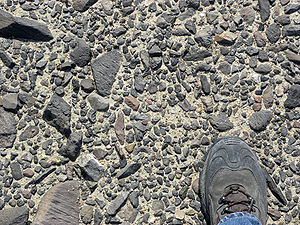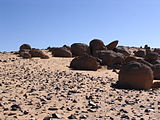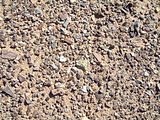- Desert pavement
-
A desert pavement is a desert surface that is covered with closely packed, interlocking angular or rounded rock fragments of pebble and cobble size.
Contents
Formation
Several theories have been proposed for their formation.[1] The more common theory is that they form by the gradual removal of the sand, dust and other fine grained material by the wind and intermittent rain leaving only the larger fragments behind. This does not continue indefinitely, however, because once the pavement has been formed it can act as a barrier to further erosion. Secondly, it has been proposed that desert pavement forms from the shrink/swell properties of the clay underneath the pavement; when precipitation is absorbed by clay it causes it to expand and later when it dries it cracks along planes of weakness. This geomorphic action is believed to have the ability to transport small pebbles to the surface over time; it stays this way due to the lack of abundant precipitation that would otherwise destroy the pavement development through transport of the clasts or excessive vegetative growth.
Finally, a new theory suggests that they form as a consequence of the entrapment of fine-grained material which infiltrates below the rocky surface. This surface continues to be pushed up above the fine grained material by microbial activity which makes small bubbles that help raise the more coarse grained materials to their surface layer; this cycle of events can continue to make a thick layer of windblown dust below the pavement over the millennia. Frequently the stones are polished by the abrasion of wind-borne dust and may even be reduced to a streamlined shape with the narrow point on the windward side, becoming ventifacts.
Desert pavement surfaces are often coated with desert varnish which is a dark brown, sometimes shiny coating that contains clay minerals. In the USA a famous example can be found on Newspaper Rock in Canyonlands, Utah.
According to Ronald I. Dorn and Theodore M. Oberlander (Science Volume 213, 1981), desert varnish is a thin coating (patina) of manganese, iron and clays on the surface of sun-baked boulders. Desert varnish is formed by colonies of microscopic bacteria living on the rock surface for thousands of years. Desert varnish is also prevalent in the Mojave desert and Great Basin geomorphic province.[2]
-
Desert pavement, Ahaggar Mountains of central Sahara, southern Algeria.
-
Desert pavement in the Cima Volcanic Field of the Mojave Desert.
Local denominations
Stony deserts may be known by different names according to the region. A few examples are:
Gibbers
Covering extensive areas in Australia such as parts of the Tirari-Sturt stony desert ecoregion desert pavements are called Gibber Plains after the pebbles or gibbers[3], and so Gibber is also used in describing ecological communities such as Gibber Chenopod Shrublands or Gibber Transition Shrublands.
Reg
In Northern Africa, a vast stony desert plain is known as Reg. This term is in contrast with Erg, which refers to a sandy desert area.[4]
Hamada
A stone strewn surface in the Sahara.[5]
See also
- Aeolian processes
- Desert varnish
- Eduction (geology), a mechanism of surface rock formation
- Erg
- Saltation (geology)
- Ventifact
Notes
- ^ McFadden, L.D., Wells, S.G. and Jercinovich, M.J. 1987. Influences of eolian and pedogenic processes on the origin and evolution of desert pavements. Geology 15(6):504-508.
- ^ Dorn, R. I. and T. M. Oberlander, 1981, Microbial Origin of Desert Varnish, Science 213:1245-1247
- ^ East, J.J. 1889. On the geological structures and physical features of Central Australia. Transactions and Proceedings and Report of the Royal Society of South Australia 12:31-53.
- ^ Jean Dresch et al., Géographie des régions arides, Presses universitaires de France, Paris, 1982. ISBN 2-13-037457-3
- ^ B.W. Sparks. Geomorphology, 2nd ed., pp323. Longman Group Ltd. 1972. (ISBN 0-582-48147-3)
References
- Al-Qudah, K.A. 2003. The influence of long-term landscape stability on flood hydrology and geomorphic evolution of valley floor in the northeastern Badin of Jordan. Doctoral thesis, University of Nevada, Reno, 208 pp.
- Anderson, K.C. 1999. Processes of vesicular horizon development and desert pavement formation on basalt flows of the Cima Volcanic Field and alluvial fans of the Avawatz Mountains Piedmont, Mojave Desert, California. Doctoral thesis, University of California, Riverside, 191 pp.
- Goudie, A.S. 2008. The history and nature of wind erosion in deserts. Annual Review of Earth and Planetary Sciences 36:97-119.
- Grotzinger, et al. 2007. Understanding Earth, fifth edition. Freeman and Company. NY, NY. 458-460
- Haff, P.K. and Werner, B.T. 1996. Dynamical processes on desert pavements and the healing of surficial disturbance. Quaternary Research 45(1):38-46.
- Meadows, D.G., Young, M.H. and McDonald, E.V. 2006. Estimating the fine soil fraction of desert pavements using ground penetrating radar. Vadose Zone Journal 5(2):720-730.
- Qu Jianjun, Huang Ning, Dong Guangrong and Zhang Weimin. 2001. The role and significance of the Gobi desert pavement in controlling sand movement on the cliff top near the Dunhuang Magao Grottoes. Journal of Arid Environments 48(3):357-371.
- Rieman, H.M. 1979. Deflation armor (desert pavement). The Lapidary Journal 33(7):1648-1650.
- Williams, S.H. and Zimbelman, J.R. 1994. Desert pavement evolution: An example of the role of sheetflood. The Journal of Geology 102(2):243-248.
External links
 Media related to Desert pavement at Wikimedia CommonsCategories:
Media related to Desert pavement at Wikimedia CommonsCategories:- Aeolian landforms
- Deserts
- Sediments
-
Wikimedia Foundation. 2010.





